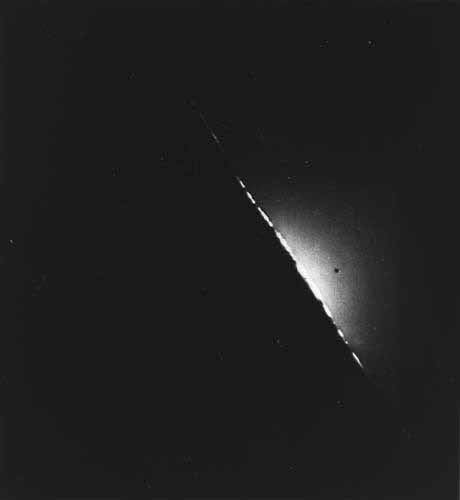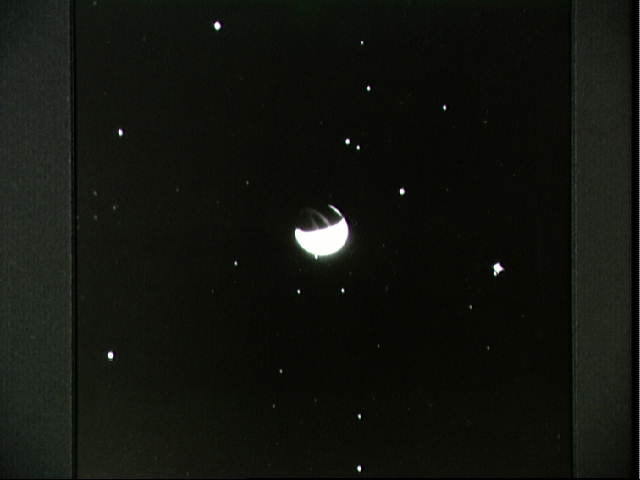|
|
|||
|
..
November 24, 1967 J. J. Rennilson1 and D. R. Criswell2
Received: 13 August 1973
|
|||
|
..
From Richard Hoagland's work... "This may be a photograph of the extraordinary glass dome covering the region of the moon known as Sinus Medii. It was taken by the unmanned Surveyor 6 on November 24, 1967, one hour after sunset." |
|||
NASA Photo ID: AS16-123-19657
File Name: 10075873.jpg
Subject terms:
|
|||
|
..
Surveyor 6 Surveyor 6 was the sixth lunar lander of the Surveyor program that explored the Moon. * Launched
November 7, 1967; landed November 10, 1967
Surveyor 6 landed on the Sinus Medii. A total of 30,027 images were transmitted to Earth. This spacecraft was the fourth of the Surveyor series to successfully achieve a soft landing on the moon, obtain postlanding television pictures, determine the abundance of the chemical elements in the lunar soil, obtain touchdown dynamics data, obtain thermal and radar reflectivity data, and conduct a Vernier engine erosion experiment. Virtually identical to Surveyor 5, this spacecraft carried a television camera, a small bar magnet attached to one footpad, and an alpha-scattering instrument as well as the necessary engineering equipment. It landed on November 10, 1967, in Sinus Medii, 0.49 deg in latitude and 1.40 deg w longitude (selenographic coordinates) - the center of the moon's visible hemisphere. This spacecraft accomplished all planned objectives and also performed a successful 'hop' rising approximately 4 m and moving laterally about 2.5 m to a new location on the lunar surface. The successful completion of this mission satisfied the Surveyor program's obligation to the Apollo project. On November 24, 1967, the spacecraft was shut down for the 2 week lunar night. Contact was made on December 14, 1967, but no useful data were obtained. Wikipedia - Surveyor 6
|
|||
|
''
Sinus Medii, November 1967 Surveyor 6 touched down in Sinus Medii, at 0.49 N, 358.60 E. Once on the surface, the spacecraft took a series of pictures and soil samples. Then, on November 17, controllers ordered the spacecraft's engines to fire, lifting Surveyor 6 off the lunar surface 3 meters (10 feet) and setting it down again a few feet from the original landing site. The spacecraft then took pictures of the former landing site, checking for evidence of a crater created by the rocket's exhaust. No crater was found, indicating that the Moon's surface was solid enough to support a manned landing. This panorama was scanned from a photographic print of a hand-assembled mosaic, then digitally reconstructed and cleaned of visual defects by Philip Stooke. Surveyor 6 Surveyor 6 touched down in Sinus Medii. Once on the surface, the spacecraft took a series of pictures and soil samples. Then, on November 17, controllers ordered the spacecraft's engines to fire, lifting Surveyor 6 off the lunar surface 3 meters (10 feet) and setting it down again a few feet from the original landing site. The spacecraft then took pictures of the former landing site, checking for evidence of a crater created by the rocket's exhaust. No crater was found, indicating that the Moon's surface was solid. Last contact with the spacecraft was December 14, 1967. |
|||
| FAIR USE NOTICE: This page contains copyrighted material the use of which has not been specifically authorized by the copyright owner. Pegasus Research Consortium distributes this material without profit to those who have expressed a prior interest in receiving the included information for research and educational purposes. We believe this constitutes a fair use of any such copyrighted material as provided for in 17 U.S.C § 107. If you wish to use copyrighted material from this site for purposes of your own that go beyond fair use, you must obtain permission from the copyright owner. | |||
|
|







